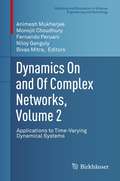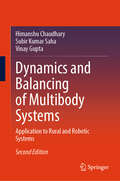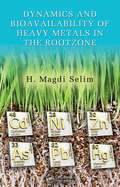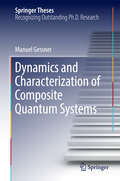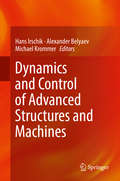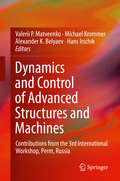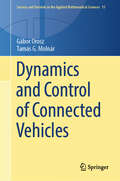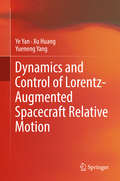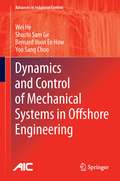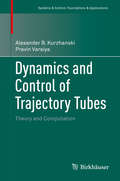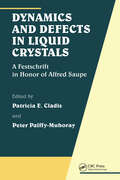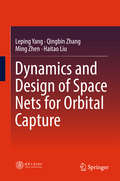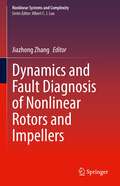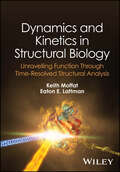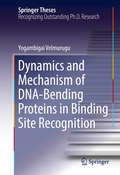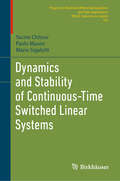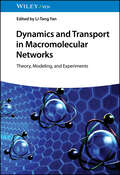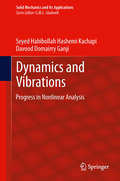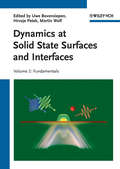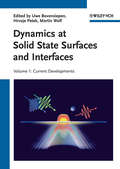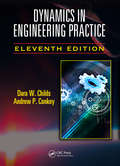- Table View
- List View
Dynamics On and Of Complex Networks, Volume 2: Applications to Time-Varying Dynamical Systems
by Animesh Mukherjee Niloy Ganguly Bivas Mitra Fernando Peruani Monojit ChoudhuryThis self-contained book systematically explores the statistical dynamics on and of complex networks with a special focus on time-varying networks. In the constantly changing modern world, there is an urgent need to understand problems related to systems that dynamically evolve in either structure or function, or both. This work is an attempt to address such problems in the framework of complex networks. Dynamics on and of Complex Networks, Volume 2: Applications to Time-Varying Dynamical Systems is a collection of surveys and cutting-edge research contributions exploring key issues, challenges, and characteristics of dynamical networks that emerge in various complex systems. Toward this goal, the work is thematically organized into three main sections with the primary thrust on time-varying networks: Part I studies social dynamics; Part II focuses on community identification; and Part III illustrates diffusion processes. The contributed chapters in this volume are intended to promote cross-fertilization in several research areas and will be valuable to newcomers in the field, experienced researchers, practitioners, and graduate students interested in pursuing research in dynamical networks with applications to computer science, statistical physics, nonlinear dynamics, linguistics, and the social sciences. This volume follows Dynamics On and Of Complex Networks: Applications to Biology, Computer Science, and the Social Sciences (2009), ISBN 978-0-8176-4750-6.
Dynamics and Balancing of Multibody Systems: Application to Rural and Robotic Systems
by Subir Kumar Saha Vinay Gupta Himanshu ChaudharyThe book describes the methodologies for dynamics formulation, balancing, and optimizing dynamic quantities of multibody systems, such as mechanisms and robots. The writing equations of motion of multibody systems are simplified by using Decoupled Natural Orthogonal Complementary (DeNOC) matrices-based methodology originally proposed by the second author. Writing equations of motion using a DeNOC based approach enables the analytical expressions of even complicated systems which provide better physical insights of the system at-hand. The DeNOC based dynamics formulation of multibody systems is extended from system of continuum rigid-link to discrete equivalent system of point-masses coined as DeNOC-P. The dynamics formulation representing a link as point-masses is exploited to minimize the dynamic quantities shaking forces, shaking moments, or driving torques/forces by optimizing the mass redistribution of the link. Several numerical examples, such as carpet scraping machine, PUMA robot, Stewart platform, etc., are illustrated. The book also demonstrates a shape optimization methodology to realize the link with optimized mass redistribution. This textbook can be prescribed for teaching a course on dynamics and balancing of multibody systems at undergraduate and postgraduate level.
Dynamics and Bioavailability of Heavy Metals in the Rootzone
by H. Magdi SelimConcerns regarding heavy metal contamination in terrestrial ecosystems have prompted increasing efforts on limiting their bioavailability in the root zone. The complexity of the hydrologic system gives rise to the need for understanding the fate and transport of trace elements in the soil-water-plant environment. Dynamics and Bioavailability of Hea
Dynamics and Characterization of Composite Quantum Systems
by Manuel GessnerThis thesis sheds new light on the fascinating properties of composite quantum systems. Quantum systems of different sizes, ranging from small bipartite systems to large many-body ensembles, can be studied with the help of modern quantum optical experiments. These experiments make it possible to observe a broad variety of striking features, including nonclassical correlations, complex dynamics and quantum phase transitions. By adopting the complementary perspectives of quantum information theory, quantum chemistry and many-body theory, the thesis develops new methods for the efficient characterization and description of interacting, composite quantum systems.
Dynamics and Control of Advanced Structures and Machines
by Michael Krommer Hans Irschik Alexander BelyaevThe papers in this volume present and discuss the frontiers in the mechanics of controlled machines and structures. They are based on papers presented at the International Workshop on Advanced Dynamics and Model Based Control of Structures and Machines held in Vienna in September 2015. The workshop continues a series of international workshops held in Linz (2008) and St. Petersburg (2010).
Dynamics and Control of Advanced Structures and Machines: Contributions from the 3rd International Workshop, Perm, Russia (CISM International Centre for Mechanical Sciences #444)
by Alexander K. Belyaev Michael Krommer Hans Irschik Valerii P. MatveenkoThe volume includes 30 contributions from the 3rd International Workshop on Advanced Dynamics and Model Based Control of Structures and Machines representing the frontiers in the mechanics of controlled machines and structures. The Workshop, held in Perm, Russia in September 2017 continued a series of international workshops, starting in with the Japan - Austria Joint Workshop on Mechanics and Model Based Control of Smart Materials and Structures, the Russia - Austria Joint Workshop on Advanced Dynamics and Model Based Control of Structures and Machines and the first two editions of the International Workshop on Advanced Dynamics and Model Based Control of Structures and Machines. The previous workshops took place in Linz, Austria in September 2008 and April 2010, in St. Petersburg, Russia in July 2012 and in Vienna, Austria in September 2015. The up-to-date contributions are authored by internationally re-known leading experts in dynamics and control representing a broad spectrum of topics in the field of Advanced Structures and Machines; both, with respect to theoretical aspects as well as applications to contemporary engineering problems.
Dynamics and Control of Connected Vehicles (Surveys and Tutorials in the Applied Mathematical Sciences #15)
by Gábor Orosz Tamás G. MolnárThis book explores the dynamics, stability, and control of connected vehicles, offering a deep dive into how vehicle networks and traffic flows are influenced by automation and connectivity. Blending theory and application, it is ideal for readers with interests in dynamical systems, control theory, and time delay systems, as well as practitioners and researchers working on vehicle dynamics, traffic modeling, and connected and automated vehicle technologies. A foundational understanding of linear control systems, differential equations, and transfer functions is recommended for readers. Structured across five insightful chapters: Chapter 1 introduces the topic and positions it within the current body of research. Chapter 2 analyzes human driver behavior and the stability of traffic involving human-driven vehicles. Chapter 3 focuses on longitudinal control in automated vehicles, including cruise and adaptive cruise control. Chapter 4 examines how vehicle-to-everything (V2X) communication enhances control strategies and enables networked vehicle coordination. Chapter 5 presents real-world experimental results using connected cruise control in mixed traffic environments. Whether you are an academic, engineer, or researcher, this book offers a comprehensive and up-to-date perspective on one of the most transformative areas in modern transportation.
Dynamics and Control of Lorentz-Augmented Spacecraft Relative Motion
by Xu Huang Ye Yan Yueneng YangThis book develops a dynamical model of the orbital motion of Lorentz spacecraft in both unperturbed and J2-perturbed environments. It explicitly discusses three kinds of typical space missions involving relative orbital control: spacecraft hovering, rendezvous, and formation flying. Subsequently, it puts forward designs for both open-loop and closed-loop control schemes propelled or augmented by the geomagnetic Lorentz force. These control schemes are entirely novel and represent a significantly departure from previous approaches.
Dynamics and Control of Mechanical Systems in Offshore Engineering
by Shuzhi Sam Ge Wei He Bernard Voon Ee How Yoo Sang ChooDynamics and Control of Mechanical Systems in Offshore Engineering is a comprehensive treatment of marine mechanical systems (MMS) involved in processes of great importance such as oil drilling and mineral recovery. Ranging from nonlinear dynamic modeling and stability analysis of flexible riser systems, through advanced control design for an installation system with a single rigid payload attached by thrusters, to robust adaptive control for mooring systems, it is an authoritative reference on the dynamics and control of MMS. Readers will gain not only a complete picture of MMS at the system level, but also a better understanding of the technical considerations involved and solutions to problems that commonly arise from dealing with them. The text provides: · a complete framework of dynamical analysis and control design for marine mechanical systems; · new results on the dynamical analysis of riser, mooring and installation systems together with a general modeling method for a class of MMS; · a general method and strategy for realizing the control objectives of marine systems with guaranteed stability the effectiveness of which is illustrated by extensive numerical simulation; and · approximation-based control schemes using neural networks for installation of subsea structures with attached thrusters in the presence of time-varying environmental disturbances and parametric uncertainties. Most of the results presented are analytical with repeatable design algorithms with proven closed-loop stability and performance analysis of the proposed controllers is rigorous and detailed. Dynamics and Control of Mechanical Systems in Offshore Engineering is primarily intended for researchers and engineers in the system and control community, but graduate students studying control and marine engineering will also find it a useful resource as will practitioners working on the design, running or maintenance of offshore platforms.
Dynamics and Control of Trajectory Tubes
by Alexander B. Kurzhanski Pravin VaraiyaThis monograph presents theoretical methods involving the Hamilton-Jacobi-Bellman formalism in conjunction with set-valued techniques of nonlinear analysis to solve significant problems in dynamics and control. The emphasis is on issues of reachability, feedback control synthesis under complex state constraints, hard or double bounds on controls, and performance in finite time. Guaranteed state estimation, output feedback control, and hybrid dynamics are also discussed. Although the focus is on systems with linear structure, the authors indicate how to apply each approach to nonlinear and nonconvex systems. The main theoretical results lead to computational schemes based on extensions of ellipsoidal calculus that provide complete solutions to the problems. These computational schemes in turn yield software tools that can be applied effectively to high-dimensional systems. Ellipsoidal Techniques for Problems of Dynamics and Control: Theory and Computation will interest graduate and senior undergraduate students, as well as researchers and practitioners interested in control theory, its applications, and its computational realizations.
Dynamics and Defects in Liquid Crystals: A Festschrift in Honor of Alfred Saupe
by Patricia E. CladisDuring his distinguished scientific career, Alfred Saupe made important contributions to liquid crystal research, laying the groundwork on which much of the current knowledge and research in the physics of liquid crystals is based. This volume features papers presented by Prof. Saupe's colleagues, students and friends at a festschrift in honor of his 70th birthday. In addition, a selection of Prof. Saupe's articles are reprinted in the original German and in English translation, offering the reader a unique opportunity to see both the early work of this important scientist and widespread effect of that work on later discoveries in liquid crystal physics.
Dynamics and Design of Space Nets for Orbital Capture
by Leping Yang Qingbin Zhang Ming Zhen Haitao LiuThis book covers the topics of theoretical principles, dynamics model and algorithm, mission analysis, system design and experimental studies of space nets system, aiming to provide an initial framework in this field and serve as a ready reference for those interested. Space nets system represents a forefront field in future development of aerospace technologies. However, it involves new challenges and problems such as nonlinear and distorted nets structure, complex rigid flexible coupling dynamics, orbital transfer of space flexible composite and dynamics control. Currently, no comprehensive books on space nets dynamics and design are available, so potential readers can get to know the working mechanism, dynamics elements, and mission design of the space nets system from a Chinese perspective.
Dynamics and Fault Diagnosis of Nonlinear Rotors and Impellers (Nonlinear Systems and Complexity #34)
by Jiazhong ZhangThis contributed volume presents recent developments in nonlinear dynamics applied to engineering. Specifically, the authors address stability and bifurcation in large-scale, complex rotor dynamic systems; periodic motions and their bifurcations in nonlinear circuit systems, fault diagnosis of complex engineering systems with nonlinear approaches, singularities in fluid-machinery and bifurcation analysis, nonlinear behaviors in rotor dynamic system with multi-mistuned blades, mode localization induced by mistuning in impellers with periodical and cyclic symmetry, and nonlinear behaviors in fluid-structure interaction and their control. These new results will maximize reader understand on the recent progress in nonlinear dynamics applied to large-scale, engineering systems in general and nonlinear rotors and impellers in particular.
Dynamics and Kinetics in Structural Biology: Unravelling Function Through Time-Resolved Structural Analysis
by Eaton E. Lattman Keith MoffatDynamics and Kinetics in Structural Biology Understand the latest experimental tools in structural biology with this pioneering work Structural biology seeks to understand the chemical mechanisms and functions of biological molecules, such as proteins, based on their atomic structures. Until recently, these structures have been studied only statically, using procedures which deliberately freeze atomic motion. However, freezing eliminates the rapid structural motions so essential to biological activity and function; the molecules are inactive. But with the recent development of X-ray free electron laser (XFEL) sources, efforts to conduct dynamic experiments have expanded using the principles of dynamics and kinetics to capture active biological molecules as they function. Dynamics and Kinetics in Structural Biology promotes the development of these experiments and their successful application. It grounds readers in the foundational principles of dynamics and kinetics; proceeds through extended discussions of experimental procedures and data analysis techniques; and explores experimental frontiers in structural dynamics. The book will aid researchers to gather and interpret cutting-edge data on the dynamic structure of biological molecules, under conditions where they retain their biological functions. Dynamics and Kinetics in Structural Biology offers readers: Authorship by founding figures in the field In-depth presentation of time-resolved X-ray crystallography, solution scattering, and more A pioneering contribution to a rapidly developing field of study Dynamics and Kinetics in Structural Biology is essential reading for graduate students, scientists, researchers and industry professionals engaged in structural studies of biological systems. Industry professionals considering dynamic studies in the development of new product lines will also benefit.
Dynamics and Mechanism of DNA-Bending Proteins in Binding Site Recognition
by Yogambigai VelmuruguUsing a novel approach that combines high temporal resolution of the laser T-jump technique with unique sets of fluorescent probes, this study unveils previously unresolved DNA dynamics during search and recognition by an architectural DNA bending protein and two DNA damage recognition proteins. Many cellular processes involve special proteins that bind to specific DNA sites with high affinity. How these proteins recognize their sites while rapidly searching amidst ~3 billion nonspecific sites in genomic DNA remains an outstanding puzzle. Structural studies show that proteins severely deform DNA at specific sites and indicate that DNA deformability is a key factor in site-specific recognition. However, the dynamics of DNA deformations have been difficult to capture, thus obscuring our understanding of recognition mechanisms. The experiments presented in this thesis uncover, for the first time, rapid (~100-500 microseconds) DNA unwinding/bending attributed to nonspecific interrogation, prior to slower (~5-50 milliseconds) DNA kinking/bending/nucleotide-flipping during recognition. These results help illuminate how a searching protein interrogates DNA deformability and eventually "stumbles" upon its target site. Submillisecond interrogation may promote preferential stalling of the rapidly scanning protein at cognate sites, thus enabling site-recognition. Such multi-step search-interrogation-recognition processes through dynamic conformational changes may well be common to the recognition mechanisms for diverse DNA-binding proteins.
Dynamics and Nonlinear Control of Integrated Process Systems
by Michael Baldea Prodromos DaoutidisPresenting a systematic model reduction and hierarchical controller design framework for broad classes of integrated process systems encountered in practice, this book first studies process systems with large material recycle and/or with small purge streams, followed by systems with energy integration. Step-by-step model reduction procedures are developed to derive nonlinear reduced models of the dynamics in each time scale. Hierarchical control architectures consisting of coordinated levels of control action in different time scales are proposed for each class of process systems considered to enforce stability, tracking performance and disturbance rejection. Numerous process applications are discussed in detail to illustrate the application of the methods and their potential to improve process operations. MATLAB codes are also presented to guide further application of the methods developed and facilitate practical implementations.
Dynamics and Predictability of Large-Scale High-Impact Weather and Climate Events (Special Publications of the International Union of Geodesy and Geophysics)
by Jianping Li Richard Swinbank Richard Grotjahn Hans VolkertBased largely on an International Commission on Dynamical Meteorology (ICDM) workshop, this timely volume, written by leading researchers in the field, covers a range of important research issues related to high-impact weather and extreme climate events. Dynamical linkages between these extremes and various atmospheric and ocean phenomena are examined, including Atlantic Multidecadal, North Atlantic, and Madden–Julian Oscillations; Annular Modes; tropical cyclones; and Asian monsoons. This book also examines the predictability of high-impact weather and extreme climate events on multiple time scales. Highlighting recent research and new advances in the field, this book enhances understanding of dynamical and physical processes associated with these events to help managers and policy makers make informed decisions to manage risk and prevent or mitigate disasters. It also provides guidance on future research directions in atmospheric science, meteorology, climate science, and weather forecasting, for experts and young scientists. Emphasises the predictability of extreme events, providing useful background information to help policymakers and managers plan for climate extremes and shorter-term forecasts of severe weather events. Provides a context for future research in the field of high-impact weather and climate extremes by compiling a wide variety of diagnostic and dynamical tools. Presents a less technical explanation of the dynamical processes involved in extreme weather events, making it accessible to a wider audience.
Dynamics and Stability of Continuous-Time Switched Linear Systems (Progress in Nonlinear Differential Equations and Their Applications #105)
by Mario Sigalotti Yacine Chitour Paolo MasonLinear switched systems are a fascinating field of research, with many theoretical questions arising from applications which require sophisticated mathematical tools for their resolution. This monograph presents a unified theoretical approach for the analysis of stability of continuous-time linear switched systems, organizing and optimizing results scattered throughout literature. Emphasis is placed on the development of a rigorous and complete mathematical theory. In addition to fundamental tools such as common Lyapunov functions, converse Lyapunov theorems, and maximal Lyapunov exponents, the concept of Barabanov norm is also discussed. While this is now well understood from a theoretical point of view, it has not received much attention in more application-focused settings, likely because this fundamental object was developed in the context of arbitrary switches but has no immediate equivalent for classes of switching signals subject to various constraints (dwell time, persistent excitation, etc.). One of the aims of this text is to bridge this gap as far as possible by explaining how the main features of Barabanov norms can be generalized for classes of constrained switchings. Throughout the text, the authors maintain a general point of view, rather than treating classes of switching signals separately, by developing an axiomatic approach and identifying structural properties of these classes that allow crucial aspects of the Barabanov norm to be extended. This monograph will be a valuable resource for mathematicians and control engineers interested in continuous-time switched linear systems, as well as a definitive reference for more experienced researchers.
Dynamics and Transport in Macromolecular Networks: Theory, Modelling, and Experiments
by Li-Tang YanDynamics and Transport in Macromolecular Networks Comprehensive knowledge on concepts and experimental advancement, as well as state-of-the-art computational tools and techniques for simulation and theory Dynamics and Transport in Macromolecular Networks: Theory, Modeling, and Experiments provides a unique introduction to the currently emerging, highly interdisciplinary field of those transport processes that exhibit various dynamic patterns and even anomalous behaviors of dynamics, investigating concepts and experimental advancement, as well as state-of-the-art computational tools and techniques for the simulation of macromolecular networks and the transport behavior in them. The detailed text begins with discussions on the structural organization of various macromolecular networks, then moves on to review and consolidate the latest research advances and state-of-the-art tools and techniques for the experimental and theoretical studies of the transport in macromolecular networks. In so doing, the text extracts and emphasizes common principles and research advancement from many different disciplines while providing up-to-date coverage of this new field of research. Written by highly experienced and internationally renowned specialists in various disciplines, such as polymer, soft matter, chemistry, biophysics, and more, Dynamics and Transport in Macromolecular Networks covers sample topics such as: Modeling (visco)elasticity macromolecular and biomacromolecular networks, covering statistical and elastic models and permanent biomacromolecular networks Focus on controlled degradation in modeling reactive hydrogels, covering mesoscale modeling of reactive polymer networks and modeling crosslinking due to hydrosilylation reaction Dynamic bonds in associating polymer networks, covering segmental and chain dynamics and phase-separated aggregate dynamics Direct observation of polymer reptation in entangled solutions and junction fluctuations in crosslinked networks, covering tube width fluctuations and dynamic fluctuations of crosslinks A much-needed overview of developments and scientific findings in the transport behaviors in macromolecular networks, Dynamics and Transport in Macromolecular Networks is a highly valuable resource for chemists, physicists, and other scientists and engineers working in fields related to macromolecular network systems, both theoretically and experimentally.
Dynamics and Vibrations: Progress in Nonlinear Analysis
by Davood Domairry Ganji Seyed Habibollah KachapiDynamical and vibratory systems are basically an application of mathematics and applied sciences to the solution of real world problems. Before being able to solve real world problems, it is necessary to carefully study dynamical and vibratory systems and solve all available problems in case of linear and nonlinear equations using analytical and numerical methods. It is of great importance to study nonlinearity in dynamics and vibration; because almost all applied processes act nonlinearly, and on the other hand, nonlinear analysis of complex systems is one of the most important and complicated tasks, especially in engineering and applied sciences problems. There are probably a handful of books on nonlinear dynamics and vibrations analysis. Some of these books are written at a fundamental level that may not meet ambitious engineering program requirements. Others are specialized in certain fields of oscillatory systems, including modeling and simulations. In this book, we attempt to strike a balance between theory and practice, fundamentals and advanced subjects, and generality and specialization. None of the books in this area have completely studied and analyzed nonlinear equation in dynamical and vibratory systems using the latest analytical and numerical methods, so that the user can solve the problems without the need of studying too many different references. Thereby in this book, by the use of the latest analytic, numeric laboratorial methods and using more than 300 references like books, papers and the researches done by the authors and by considering almost all possible processes and situation, new theories has been proposed to encounter applied problems in engineering and applied sciences. In this way, the user (bachelor's, master's and PhD students, university teachers and even in research centers in different fields of mechanical, civil, aerospace, electrical, chemical, applied mathematics, physics, and etc.) can encounter such systems confidently. In the different chapters of the book, not only are the linear and especially nonlinear problems with oscillatory form broadly discussed, but also applied examples are practically solved by the proposed methodology.
Dynamics at Solid State Surfaces and Interfaces
by Martin Wolf Hrvoje Petek Uwe BovensiepenThis two-volume work covers ultrafast structural and electronic dynamics of elementary processes at solid surfaces and interfaces, presenting the current status of photoinduced processes. Providing valuable introductory information for newcomers to this booming field of research, it investigates concepts and experiments, femtosecond and attosecond time-resolved methods, as well as frequency domain techniques.The whole is rounded off by a look at future developments.
Dynamics at Solid State Surfaces and Interfaces: Current Developments
by Martin Wolf Hrvoje Petek Uwe BovensiepenThis two-volume work covers ultrafast structural and electronic dynamics of elementary processes at solid surfaces and interfaces, presenting the current status of photoinduced processes. Providing valuable introductory information for newcomers to this booming field of research, it investigates concepts and experiments, femtosecond and attosecond time-resolved methods, as well as frequency domain techniques. The whole is rounded off by a look at future developments.
Dynamics at Solid State Surfaces and Interfaces: Volume 1 - Current Developments
by Martin Wolf Hrvoje Petek Uwe BovensiepenThis two-volume work covers ultrafast structural and electronic dynamics of elementary processes at solid surfaces and interfaces, presenting the current status of photoinduced processes. Providing valuable introductory information for newcomers to this booming field of research, it investigates concepts and experiments, femtosecond and attosecond time-resolved methods, as well as frequency domain techniques. The whole is rounded off by a look at future developments.
Dynamics in Engineering Practice (Applied and Computational Mechanics)
by Andrew P. Conkey Dara W. ChildsObserving that most books on engineering dynamics left students lacking and failing to grasp the general nature of dynamics in engineering practice, the authors of Dynamics in Engineering Practice, Eleventh Edition focused their efforts on remedying the problem. This text shows readers how to develop and analyze models to predict motion. While esta
Dynamics in Enzyme Catalysis
by Sharon Hammes-Schiffer Judith KlinmanChristopher M. Cheatum and Amnon Kohen, Relationship of Femtosecond-Picosecond Dynamics to Enzyme-Catalyzed H-Transfer. Cindy Schulenburg and Donald Hilvert, Protein Conformational Disorder and Enzyme Catalysis. A. Joshua Wand, Veronica R. Moorman and Kyle W. Harpole, A Surprising Role for Conformational Entropy in Protein Function. Travis P. Schrank, James O. Wrabl and Vincent J. Hilser, Conformational Heterogeneity Within the LID Domain Mediates Substrate Binding to Escherichia coli Adenylate Kinase: Function Follows Fluctuations. Buyong Ma and Ruth Nussinov, Structured Crowding and Its Effects on Enzyme Catalysis. Michael D. Daily, Haibo Yu, George N. Phillips Jr and Qiang Cui, Allosteric Activation Transitions in Enzymes and Biomolecular Motors: Insights from Atomistic and Coarse-Grained Simulations. Karunesh Arora and Charles L. Brooks III, Multiple Intermediates, Diverse Conformations, and Cooperative Conformational Changes Underlie the Catalytic Hydride Transfer Reaction of Dihydrofolate Reductase. Steven D. Schwartz, Protein Dynamics and the Enzymatic Reaction Coordinate.
